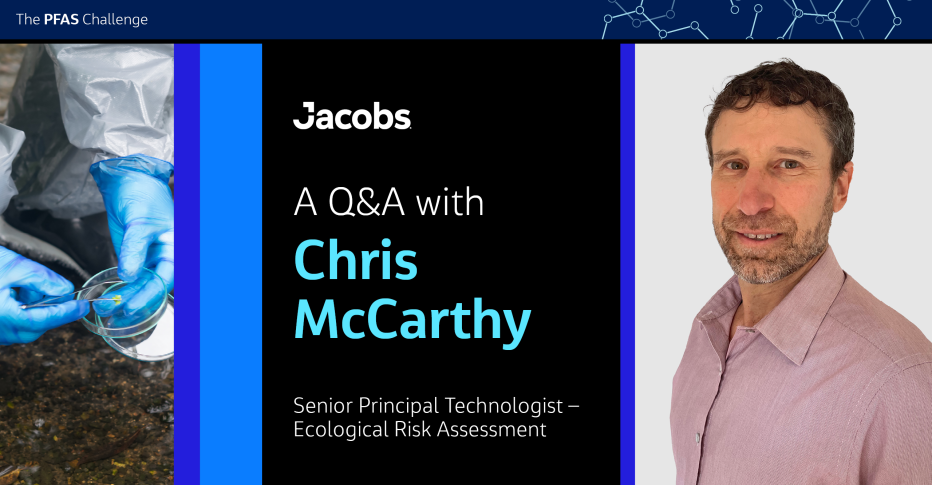
Per- and polyfluoroalkyl substances (PFAS) are now found worldwide, even in isolated, remote areas like Antarctica. Recent research shows that high PFAS concentrations can adversely affect us, and it has led to the lowering of regulatory thresholds.
While these new thresholds are a step forward and will result in lower levels of PFAS in the future, the sheer volume of PFAS contamination globally means we can’t remediate all the PFAS already in the environment to meet them. The way forward requires cleaning up what is possible and then using institutional controls such as fishing bans or land use restrictions to limit human exposure to PFAS.
However, while these controls work for humans, they don’t work for all other species. We need a better understanding of the potential impacts of PFAS exposure on the wider ecosystem to determine where and how to protect the rest of the species. This is where Chris McCarthy and his deep expertise are vital: ecotoxicology is the study of toxic or adverse effects that occur in plants, animals, populations, communities and ecosystems resulting from exposure to a substance or substances.
In this Q&A, Chris gives his perspective on the trends shaping ecotoxicity today and how we’re co-creating environmental solutions with our clients for a better tomorrow.
Tell us a bit about your current role and how ecotoxicology is critical to the PFAS solution.
Since 1997, I’ve been building up my ecological risk assessment skills and experience and working as an applied scientist across several projects, industry groups, a research grant and several communities of practice. In my current role as Senior Principal Technologist, I focus mostly on Ecological Risk Assessment, and in 2023, I was certified by the International Board of Environmental Risk Assessors (IBERA) as an IBERA Diplomate or certified environmental risk assessor. Now, I focus my time on identifying emerging challenges for our society and clients and the solutions our Ecological Risk group could bring, especially within the PFAS challenge. I constantly review the makeup and skills of the group to respond to how the industry is changing and to discover opportunities.
Ecological risk assessment — or eco risk assessment — is integral to the contaminated site remediation process. Risk assessors combine knowledge of ecology, toxicology and chemistry to evaluate the likelihood that a substance released into the environment will adversely affect the plants, animals and ecosystems exposed to that substance. We try to understand the magnitude of the effects. Then, we convey the risk assessment outcomes to risk managers to empower them to make the right decisions regarding the next steps.
How do we help clients think differently to respond to the future?
We prioritize being in the rooms where the toughest questions about PFAS ecological risk are being asked, solutions are being proposed and tested, and results are being interpreted. Our global team offers our clients a deep understanding of the PFAS challenge in scientific theory and real-world application.
These insights aren’t just garnered from our client work in the field. They’re also informed by conducting lab research, participating in technical workgroups, developing industry guidance, giving training, publishing peer-reviewed work and performing peer reviews for many other PFAS-focused articles. As a global team, we’re bringing an industry-tested perspective and proven solutions informed by more than a decade of deep immersion in this issue.
One recent example of this is when Shaun Roark, a fellow Jacobs eco risk assessor, and I were invited to attend a U.S. government-focused meeting on PFAS ecological risk. The research organization comprises of the Department of Defense, the Environmental Protection Agency (EPA), and the Department of Energy. We were tasked with identifying the gaps we saw in PFAS ecological risk assessment, which were most pressing, and what we saw as potential solutions. My subgroup was tasked with thinking about how we tackle handling PFAS mixtures and whether or how we could use a few PFAS as indicator chemicals for making more informed risk management decisions while we continue to work on other data gaps.
What trends are you seeing within PFAS exposure and risk assessment?
Most current and past PFAS research focuses on exposure concentrations in natural settings near known sources of PFAS, such as fire training areas where firefighting foam was used or near contaminated air stack emissions. Exposure concentrations are an expression of contaminants that humans or wildlife experience daily. These contaminants can be in our water, air, the things that touch our skin or our food.
A trend we’re seeing is there are a growing number of studies looking at exposure within different components of food webs, which are the feeding connections between organisms in an ecosystem. This trend can help us determine which are the most vulnerable to a negative impact. Like, for example, it could be the apex predators as some of the PFAS are bioaccumulative, or it may affect mid to lower trophic levels that are less mobile or have localized exposures. It may also provide an opportunity to identify candidate species as “indicators” which can represent the exposure and potential adverse effects so we don’t need to monitor every species.
These studies start at the lowest trophic or food chain levels exposed directly to PFAS in soil, surface water, and sediment to wildlife exposed through consuming prey that contain PFAS in their tissues. These food web exposure studies are more challenging when the animals are migratory or have large home ranges and can be exposed in different areas with completely different PFAS sources. This makes it more difficult to identify which PFAS are causing the problems.
What are the biggest opportunities in your field?
The greatest one would be the intersection of ecological risk assessment and management with nature-based solutions as we focus on managing whole ecosystem health due to climate change.
It’s also critical to find new ways to manage past and future impacts of plastics and other materials in the environment without focusing on chemical concentration. Ecological risk assessment frameworks have traditionally focused on concentrations of environmental stressors, but we need to think differently to address these issues (like with microplastics) where shape, mass and physical properties are becoming more relevant.
One of the most exciting opportunities is with New Approach Methods (NAMs), a broad category of methods that avoid or minimize animal testing when studying the toxic effects of chemicals. NAMs include a variety of approaches, including cellular, subcellular, genomics, computer models and artificial intelligence. Using NAMs within risk assessment is accelerating and offers a lot of promise to close the gaps in uncertainties in ecotoxicology. While the concept of NAMs is not new, collecting and applying data to support their use is gaining momentum and providing new opportunities within human health risk assessment and environmental risk assessment. The global attention on PFAS has had a major influence on the growth of implementing NAMs to solve our current environmental risk problems.
Is there a project you’re particularly proud of?
I led a project exposing freshwater aquatic invertebrates to six different PFAS. The goal was to close data gaps in understanding their toxicity relative to each other. I carefully designed the experiments to answer questions about toxicity at concentrations we’re seeing in the natural environment.
However, the project had much more long-term value. While working on it, I realized the results could be valuable for developing criteria for regulatory agencies such as the EPA. The results were published in a peer-reviewed journal and became a critical component of the U.S. EPA’s final ambient water quality criteria documents for PFOS and PFOA.
About the interviewee

Chris McCarthy has over 25 years of environmental consulting experience. Chris is an IBERA Diplomate, certified by IBERA as an environmental risk assessor and he is certified as a senior ecologist by the Ecological Society of America. He develops risk management strategies and directs teams in evaluating effects to human and non-human biota exposed to contaminants at hazardous waste sites. He actively participates in technology transfer activities being a trainer and active member of PFAS working groups for the Interstate Technology and Regulatory Council (ITRC), Society of Environmental Toxicology and Chemistry (SETAC) and Strategic Environmental Research and Development Program (SERDP)/ Environmental Security Technology Certification Program (ESTCP). He also is a globally recognized ecotoxicologist presenting at national and international conferences.














































